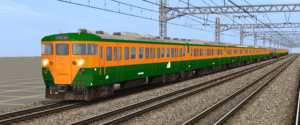
DOWNLOAD
This is a reskin of Keinchiro’s 113 Series upgraded by Hirochi. All the necessary dependencies are included in this package, avaible on the DLS or from Rizky’s website .
The green cars are a reskin of Kenichiro’s 485 Series upgraded by Hiorchi (for the former limited express train ones) and of the E231-1000 Series (for the double-decker ones) of Rizky_Adiputra, also avaible on his website.
After the privatisation, JR East had inherited a conspicuous fleet of 113 Series trains from JNR, divided into two areas: the “Tokaido Line” trains in the Shonan Livery, and the “Yokosuka-Sobu Lines and Chiba-Boso Areas” in the blue-and-cream Yokosuka Livery.
The former ones were primarily formed in -11 and -4 car sets (generally coupled togheter to form 15-car sets) and were used on Tokaido Main Line rapid services from Tokyo to Atami and on the Ito Line.
Each train also had two “green-cars” (first-class, reservation-only cars for long-distance commuting) besides the “standard” ones.
These could either be the “newly-built” SaRo 111, 112 and 113 types, wich were made between 1964 and 1972 (togheter with the 113 Series trains) and used the same bodyshell design as the standard cars (altough with only two single-leaf doors instead of three double-leaf ones), or the SaRo 110 type, wich were former green cars of 183 and 189 Serieses limited express trains (surplus due to the opening of the Shinkansen) or the SaRo 124 or 125 type (introduced after the privatisation of JNR), wich were stainless-steel double-decker cars based on the 211 Series’ ones.
After the late 1980s, a Tokaido Line rapid service had always a stainless-double decker car and either a “newly-built” or “former-limited express” single-deck one, with the two being placed in the exact centre of a 15-car formation.
Even before it’s privatization, the JNR were looking for a cost-effective replacement for 113 Series trains, in the same way as they were looking for a replacement for the 103 Series.
Not casually, the two were developed togheter: the 205 Series to replace 103s and the 211 Series to replace the 113s. Both, in fact, shared most electrical equipment and the same stainless steel construction.
211 Series trains had been introduced on Tokaido Line services in 1986, and even after privatisation, the newly-formed JR East had found out that the 205 and 211 Serieses were perfectly suited to it’s needs back then, and so the company decided to continue 205 and 211 Series production, rather than designing an entirely new suburban train (like all the rest of the JR-group companies did).
With the introduction of JR-East-built 211 Series sets, the fleet of Tokaido Line 113 Series trains gradually thinned, and with a general reorganization of the 113 Series formations in 1998, the “former limited-express” green cars were removed from the roster and scrapped.
Shortly after, in 2000, the final replacement for 113 Series trains was introduced: the E231-1000 Series.
Part of JR East’s E231 Series family, it was a suburban version of the E231-0 Series for commuter services introduced a few years before. Depsite sharing most electrical equipment, the E231-1000s had a sightly different bodyshell than “standard” E231-0s, most notably, they had a bigger cab, rised driving position and top-mounted headlight, all of wich were fetaures that were later used in the E231’s successor: the E233 Series.
By the mid-2000s, E231-1000 Series trains had replaced most of the remaining 113s, and on the 16th of March 2006, a Tokaido Line 113 Series made its way from Tokyo to Atami for the last time, effectively ending an era that lasted more than 40 years.
Bonus Video:
The atmosphere of Tokaido Line 113 Series trains shortly before their retirement.
A now historic HD video made in 2006 (!) by YouTube user IchiPika
